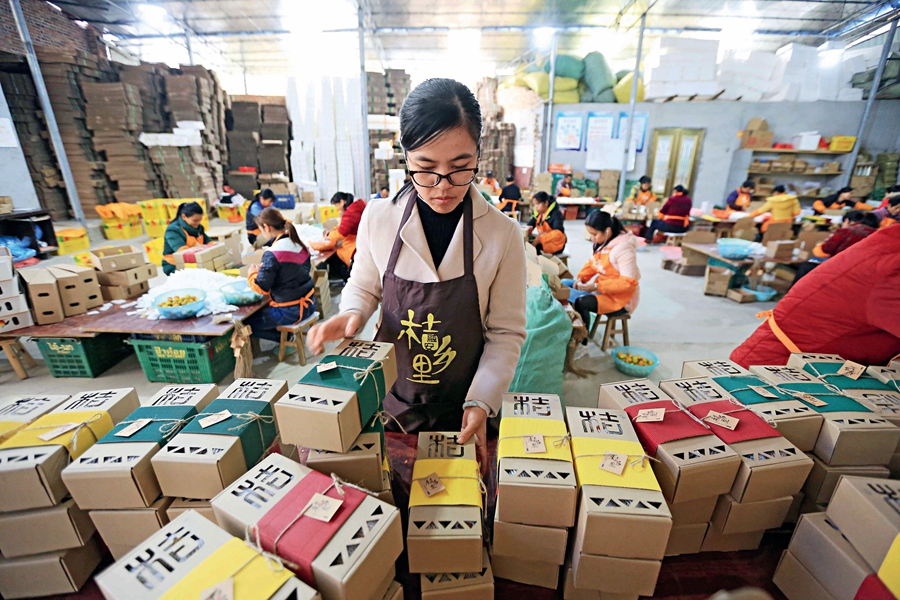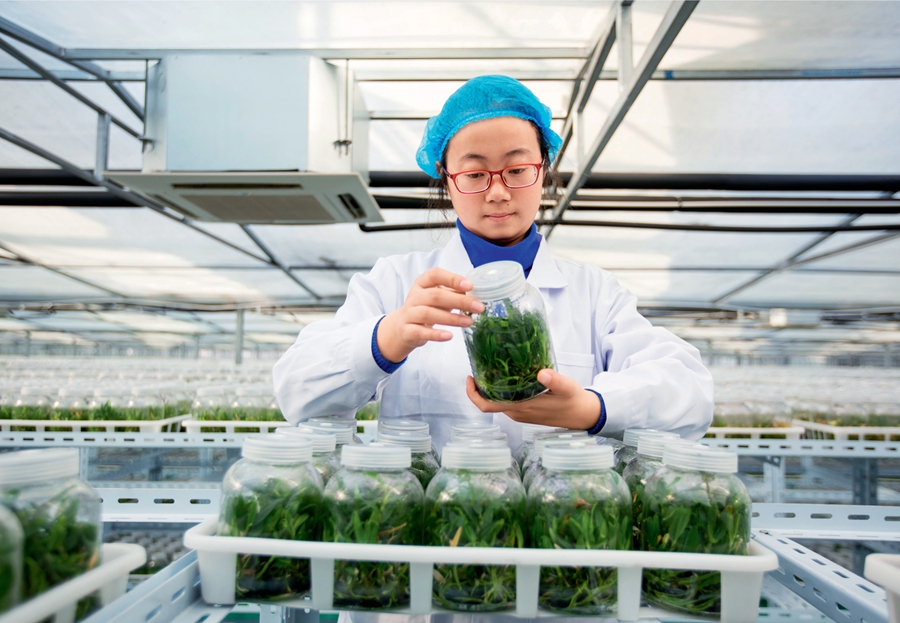By ZHANG LIJUAN
By ZHANG LIJUAN
AS China’s reform and opening-up drive steers into its fifth decade, the country released the Opinions on Implementing the Rural Vitalization Strategy, mapping out the policy blueprint for speeding up modernization of agriculture and rural areas in a socialist way with Chinese characteristics.
The Opinions called on the whole Party and all sectors of the country to advance the comprehensive upgrading of agriculture, progress of rural areas in all respects, and farmer’s development in an all-around way. The rural vitalization is not only about economic development, but also related to all other aspects of the countryside, involving political, cultural, social, and ecological progress.
According to the Opinions, by 2020, the institutional framework and policy system will take shape as the rural vitalization drive makes important headway; by 2035, modernization of agriculture and rural areas will fundamentally become a reality with decisive progress made; by 2050, rural areas should have strong agriculture, a beautiful environment, and well-off farmers, rural vitalization fully achieved.
Rural Changes
As China’s reform and opening-up drive kicked off four decades ago, economic system reform was also carried out in rural areas. Based on the collective ownership of land, household contract responsibility management was introduced in the countryside. The move of industry nurturing agriculture and cities supporting rural areas had brought about the rapid development of commerce, industry, and transportation in the countryside, and big changes happened in rural areas.

Farmers take to e-business to boost their sales of farm produce.
As farmers swarmed into cities to find jobs, their contracted land was underutilized. However, the country has not taken back farmers’ land contract right, but instead extended the term of their contracts, encouraging them to transfer the management right of land. Thus farmers become shareholders and agricultural workers.
China’s Rural Development Report 2017, released by the Chinese Academy of Social Sciences, lists those drastic changes that have occurred in China’s rural economy and society in recent years: the narrowing regional disparity, the orderly advancement of collective property right system reform, diversification of entrepreneurs, emergence of new industry, business activities and models, rapid development of the rural land transfer market, substantial development of new and innovative rural financial institutions, village rules and conventions to regulate rural public affairs playing a positive role in maintaining rural social order and implementing national policies, and huge achievements made in the rural medical care and social security areas.
All these have laid a foundation for the formulation and implementation of the rural vitalization plan.
Practices in Agricultural Modernization
To develop rural areas, agriculture holds the key. Therefore, boosting agriculture and bringing the benefits to farmers has topped the agenda of rural vitalization. Efforts should be made to cultivate robust industries, which then can prop up the rural vitalization program. Households and farmers’ cooperatives, together with new business operators like leading agricultural enterprises, can play a major role in promoting industrial development.
Rural areas across the country are exploring ways to propel rural development. In 2011, 18 farming dab hands of Houhou Village in Xingyang City of Henan Province set up the Xintiandi Plantation Specialized Cooperative, and established plants of agricultural production in 50 villages of Xingyang City, providing local farmers a whole package of socialized services involving the whole process of grain production. The cooperative also has cooperation with more than 30 mills, 20 feed factories, and Henan Wanxi Pharmaceutical Co., Ltd., ensuring the timely purchase of farmers’ grain harvests.
With 203 households now participating, the Xintiandi Cooperative has mobilized 12,000 farm households in its neighboring seven towns and townships to plant new species of wheat and corn with yearly output more than 50 million kg.
Dongwangzhuang Village in Xigang Town of Shandong’s Tengzhou City has not been endowed with good farming conditions. Many local farmers have chosen to become migrant workers, leaving their farmland unattended. To boost local agricultural development, Tengzhou Supply and Marketing Cooperative decided to introduce a shareholding land trusteeship model: local farmers became shareholders with their land of 70 hectares, Xigang Farmers’ Service Center contributed RMB 420,000 to the stake pool, and the village collective joined the shareholding scheme with the non-contracted village land, the newly-reclaimed land, and farming facilities. Apart from the minimum guarantee dividend RMB 900-1,000 per mu (1/15 hectare), farmers can also earn dividends from earnings. As of now, the village has consigned all its land to the trustee for management, which brings an annual income increase of RMB 100,000 to the village collective, and a revenue growth of RMB 2.36 million to farmers.
Now, Tengzhou’s practice has been promoted in many agricultural provinces, boosting agricultural yields, farmers’ income, and the cooperative’s earning.
The Role of Science and Technology
Traditional agricultural products can only earn farmers little profits. Therefore, raising the value added of agricultural produce via science and technology becomes an important way to increase farmers’ income.
General Manager of Hainan Wanzhong Co., Ltd. Li Yusheng has been in the agricultural field for 21 years. Aware of the fact that above 95 percent of pineapples planted in China were the Bali species eight years ago, Li decided to develop a more profitable variety. After years of efforts, Li’s team, by cooperating with colleges, has developed a whole set of “golden pineapple” planting techniques covering all cultivation steps from irrigation, fertilizing, to seedling nursing.

A worker screens the disqualified seedlings of dendrobium officinale (a species of orchid, often used in traditional Chinese medicine) at the tissue culture plant of Dongbei Village in Xinghua City of Jiangsu Province on December 22, 2017.
Spearheaded by Li’s golden pineapple base, Hainan’s golden pineapple industrial cluster has been formed with standardized plantations. An industrial chain featuring high quality and sustainable development is taking shape. Li’s golden pineapple base hires more than 1,000 workers for plantation.
Now, Li is trying to connect his plantation base with the nearby expressway, a move to improve the overall facility of the base and promote its development. In addition, he also plans to set up a pineapple deep processing plant so as to advance the vertical integration of the primary, secondary, and tertiary industries in the pineapple business of Hainan’s Ledong County, along with increasing profits of agricultural products.
“To give a boon to the pineapple industry, it’s necessary to go beyond the boundary of agriculture, realizing the integrative development of primary, secondary, and tertiary industries. This will make farming more lucrative, ensure the steady increase of farmers’ income, enhance the cohesion of rural grass-roots organizations, and turn the countryside into a beautiful place, thus achieving rural modernization in the new era,” said Kong Xiangzhi, a professor with the School of Agricultural Economics and Rural Development under Renmin University of China.
Industry Nurturing Agriculture
Modern agriculture inevitably features the integrative development of primary, secondary, and tertiary industries. Modernized rural areas will also undoubtedly witness coordinated urban-rural development. Under China’s former urban-rural dual structure rural areas and farmers contributed greatly to the country’s urban development. Now it’s time for cities to fuel rural development.
Renlaotun Village of Shandong Province’s Dongming County has a weak industrial base. However, in recent years, the influence of China’s e-commerce platform taobao.com has gradually penetrated into the area, and boosted local online business. In 2015, local farmer Zhu Yongjin first sold online decorative paintings made by himself, which won favor of multitudinous clients owing to their strong local flavors. Then Zhu began to sell a range of products including local brocades, paper cuttings, and farm products online. He became the first e-business dabbler of the village. As his online shop saw increasing orders and rising sales volumes, in 2016, Zhu established the Dongming County Ali E-business Co., Ltd., the e-business service center of Dongmingji Town, and the express service center of the town. As of now, farmers of Renlaotun Village have opened 72 online shops with 150 persons involved in the e-business and the annual sales summing up to RMB 20 million.
“In exploring the development path of modern agriculture, we should pay attention to the following aspects: improving the technological content of agriculture, in particular about incubation and innovation of plantation techniques; enhancing the development of smart agriculture; advancing close combination of agriculture and modern finance,” Party Secretary of Anhui Agricultural University Jiang Chun pointed out.
“The proposal of rural vitalization aims to narrow the urban-rural development gap and ameliorate the current situation that the progress of agricultural modernization lags behind that of the country’s industrialization, informatization, and urbanization,” Chairman of China Well-off Society Association Wang Julu remarked. “Modern agricultural development will inevitably promote the integrative urban-rural development and integration of the primary, secondary, and tertiary industries,” Wang added.
ZHANG LIJUAN is a reporter with China Report.